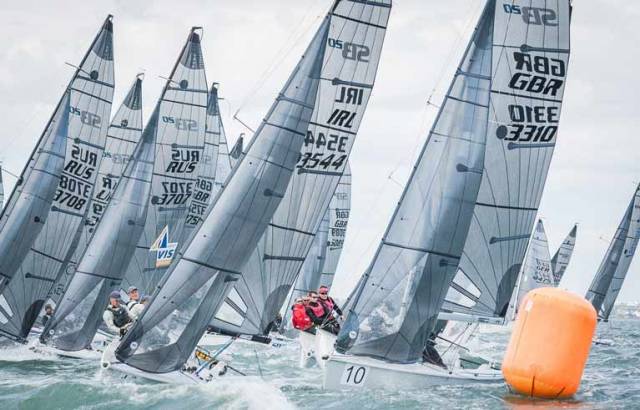Michael O'Connor and the Sin Bin crew of Ed Cook and Davy Taylor took third overall and the top Irish result at last week's SB20 European Championships at the Royal Irish Yacht Club. Here, the Royal St. George Yacht Club helmsman, who won the Corinthian World Title in Cowes in 2017, details his campaign preparations that led to bronze medal success on home waters.
Now that the dust has begun to settle after the 2018 SB20 European Championships, I have been asked to put together some notes on our preparation for the event. Everyone approaches these things differently and I am not suggesting that how we prepared was better or worse than any other campaign, this is simply an account of what we did to prepare ourselves as best we could.
It seems to make sense to divide the notes into two separate stages: (1) preparation before the event (sailing and boat preparation); and (2) preparation during the event.
Sailing preparation before the event
Our preparations for the 2018 Europeans began almost two years ago when it was announced that the event was to be held in our home waters of Dublin Bay. On the sailing front, we decided that in addition to the Irish events, we needed to do as many international regattas as we could manage to get more experience racing in larger fleets against high-quality competition. These regattas included the UK Nationals in 2017 and 2018, the Worlds in Cowes in 2017, the Worlds in Tasmania in January 2018 and a regatta in Cascais in April 2018 against high-quality Portuguese, Russian and Ukrainian competition.
 Sin Bin broaches – this photo was after we rounded the weather mark in first place and it dropped us to 7th in that race, our worst result of the day. As a suggested caption “You can do all the practice you want but if you don’t bear off when putting up a kite in 20+ knots…” Alternatively, “to paraphrase Mike Tyson: it’s all very well having a plan in place until you are hit by a gust…” Photo: Anna Zykova
Sin Bin broaches – this photo was after we rounded the weather mark in first place and it dropped us to 7th in that race, our worst result of the day. As a suggested caption “You can do all the practice you want but if you don’t bear off when putting up a kite in 20+ knots…” Alternatively, “to paraphrase Mike Tyson: it’s all very well having a plan in place until you are hit by a gust…” Photo: Anna Zykova
After each major event, we would identify areas that we needed to work on and we would go away and work on those before the next event. For example, after the Worlds in 2017, we were happy with our upwind speed but we felt that the Russian and Australian teams had an edge downwind in heavier winds. Also, we felt that we were “sticky” when lazy planing, that zone between soaking and full planing that the UK teams were so good at… so we went away and worked on those aspects until we felt we were up to speed. At the UK nationals this year, we identified that two UK boats, in particular, were able to sail a little lower than us when planing without losing much distance. This mode can be essential in an asymmetric kite boat to prevent you getting locked out towards the port layline downwind. So we worked on this to develop a lower mode when planing downwind and it proved useful in the Europeans. After the Irish Eastern Championships in early August 2018, the Russian VIS Team (the eventual European Champions) gave the Irish fleet a complete spanking in light airs, they were virtually untouchable, and we have been working on our light air performance since. I guess you could say that it is still a work in progress.
At home, our aim was to sail together as often as possible and at least three times each week. The stories of John Lavery and David O’Brien sailing every morning in Dun Laoghaire before work in 1995 before winning the Fireball World and Europeans are still fresh in the memory and we wanted to emulate their commitment if we could. In addition to DBSC racing on Thursdays and Saturdays which were useful for starting and racing practice, we would train for several hours on Saturday mornings before racing and also on Friday evening or Sunday morning, attempting to improve tacks, gybes and general manoeuvres. One of our team, Ed Cook, started a new job in London at the beginning of this summer so Ed would commute on Wednesday nights/Thursday mornings to make the sailing on Thursday evenings. We didn’t get close to the Lavery/O’Brien commitment levels of sailing every day but we did as much as we could…
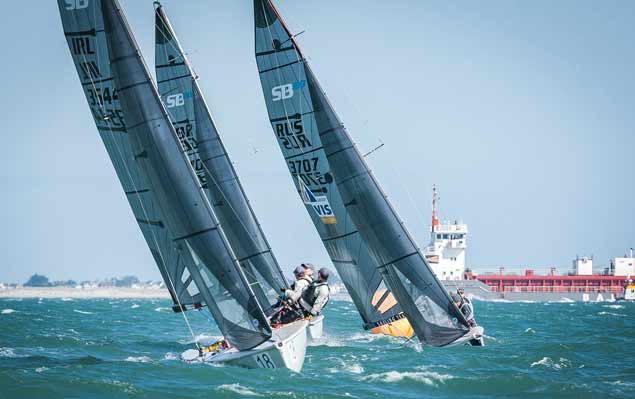 Sheperd them home – This is the last leeward rounding of race 1, from where we lead the Russians and Martin Boatman GBR to the finish to win our first race in an international regatta (we had 2 second places in the Worlds in Cowes, a second place in the Worlds in Tasmania, and a second place in race 3 of the Europeans but we had never won a race at a major event) – we had dropped the kite a little early to be on the safe side and the competition got a lot closer that we would have liked. Here they were about 3-4 boat lengths behind us. Photo: Anna Zykova
Sheperd them home – This is the last leeward rounding of race 1, from where we lead the Russians and Martin Boatman GBR to the finish to win our first race in an international regatta (we had 2 second places in the Worlds in Cowes, a second place in the Worlds in Tasmania, and a second place in race 3 of the Europeans but we had never won a race at a major event) – we had dropped the kite a little early to be on the safe side and the competition got a lot closer that we would have liked. Here they were about 3-4 boat lengths behind us. Photo: Anna Zykova
One area that we have been particularly interested in improving this year is kinetics. From watching the tracker of the Melges Worlds 2016, we could see that the Irish boat Embarr (with Prof O’Connell et al on board) appeared to be consistently lower and faster than their competitors downwind. We then saw a video of Embarr and it was evident that they were sailing the boat far more aggressively than their competitors, using their weight to manhandle the boat downwind. We tried a number of times to get a few sessions in with Prof to work on this, however, we were scuppered by the wind (twice) and busy work schedules, so it is another one to work on in the future. We were however very fortunate to have Shane Hughes of North Sails run a clinic with just ourselves and Broomsticks (IRL 3537 Marty O’Leary, Brian Fenelon, Paddy Kirwan and Rachel Williamson) before the Europeans where we were able to concentrate on and really improve this area of our sailing.
 Training partners fighting it out on the course…this shows us going downwind with our training partner, Broomsticks (Marty O’Leary et al), with the red kite in the foreground. I believe that this is from race 3 where we came second and Broomsticks were third Photo: Anna Zykova
Training partners fighting it out on the course…this shows us going downwind with our training partner, Broomsticks (Marty O’Leary et al), with the red kite in the foreground. I believe that this is from race 3 where we came second and Broomsticks were third Photo: Anna Zykova
Boat preparation before the event
In addition to the sailing preparation, boat preparation has been a massive part of the campaign. All of the work on our hull and keel is done exclusively by Edwin Brennan. Edwin is a perfectionist and in my opinion, his work is second to none. I always say to anyone that needs to get work done on their boat, if you want it to be perfect, get Edwin to do it. We were fortunate to get the loan of a 1720 trailer from Ronan Adams in the Royal St George Yacht Club in the lead up to the Europeans and Edwin was able to repair some recently acquired deep scratches in the keel bulb and fin and respray the entire keel before the event so that it was exactly how we wanted it.
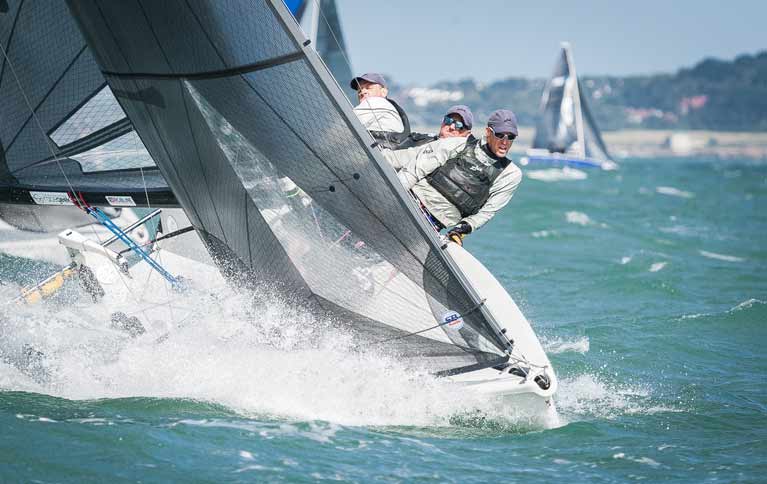 This was from race 3 (we were second pretty much all the way around and here we are chasing down John Pollard, the UK National Champion) - you can see the pain in our faces – from left to right O'Connor, Taylor and Cook Photo: Anna Zykova
This was from race 3 (we were second pretty much all the way around and here we are chasing down John Pollard, the UK National Champion) - you can see the pain in our faces – from left to right O'Connor, Taylor and Cook Photo: Anna Zykova
In addition to the hull, a lot of work went into perfecting the systems. This area is definitely not my forte, however, I have been blessed to sail with two guys, Davy Taylor and Ed Cook, who it seems live for this stuff! Davy, in particular, knows SB20s like the back of his hand and Ed has a great analytical mind to solve the tricky problems. Over the last 12 months, Davy and Ed have been keeping a close eye on other boats in the fleet to see what everyone else is up to and to see if we can learn from them and improve our systems in any way, as well as coming up with their own ways to improve our systems. This might mean that we can lose a couple of ounces on a shackle or a fitting somewhere, or we can speed up our spinny hoists by reconfiguring the retrieval line. Together, they have “turboed” Sin Bin to within an inch of her life!
Everything on the boat works and if we think something might need replacing, it is replaced straight away. When the boat came back from Tasmania in March of this year, we removed all of the fittings from the hull and ran a dehumidifier in the boat for several weeks to dry the boat out fully. Thereafter, we sealed and reattached all of the fittings, replaced any tired fittings, and beefed up certain fixtures like the traveller cleats so that we could roll tack more aggressively in light airs.
In relation to sails, we don’t have a choice of sail manufacturer in the SB20 fleet as this is chosen by the supplier, however, we had a new main, jib (x2) and spinny for the Europeans. We took both jibs out the weekend before the event to shake them out and we chose the one that we felt looked better for the conditions.
Preparation during the event
Every morning of the event, we would meet at 9 am for 20 minutes in Barry O’Neill’s penthouse apartment overlooking Dublin Bay. There, we would have a great view of the wind moving across the bay. Barry is a former Olympian (in the Flying Dutchman class) and I had the privilege of sailing with Barry for many years in J24s. Barry has spent the last 40 years sailing in Dublin Bay and I cannot think of anyone who knows the tides and winds of Dublin Bay better than Barry (Barry also sold me Sin Bin in 2015 so he knows SB20s too!). Each morning, Ed, Davy and I would sit down over a coffee with Barry and discuss the forecast for the day, the likely area of the race course (Barry now does a lot of race officer work in Dublin Bay so he has great insight into what might happen from a race management perspective) and the tidal effects on the race course throughout the day. This routine was invaluable as it got our minds focused on the day ahead.
For the tides, we had printed out (on A4 sheets that were then laminated) screenshots from the Dublin Bay tidal atlas at 0.5-hour intervals. For the forecasts, we used Weather4D with Arome HD forecasting models as recommended by Shane Hughes of North Sails. We found the accuracy of the Arome HD excellent and I believe it provided better granularity than other forecasting models.
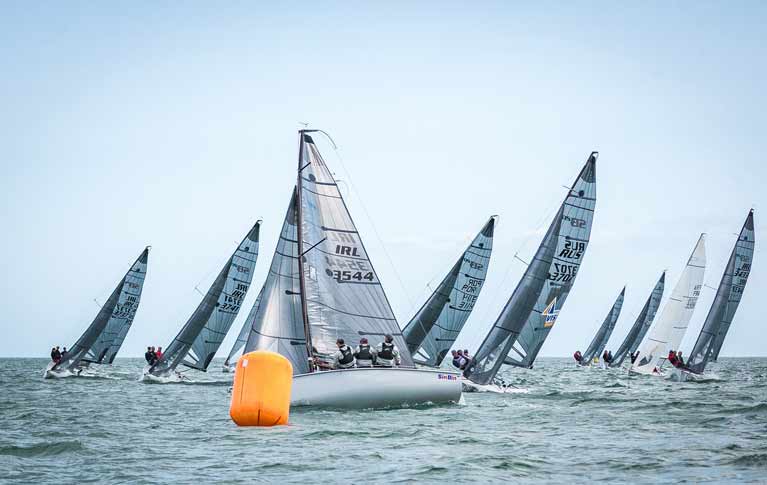 From day 2, race 1 - We were leading the Russians VIS 3707 (eventually winners) into the weather mark here – they are the black boat on starboard. You can also see the Portuguese national champion, Vasco Serpa, coming up on starboard to weather of the Russians. (Vasco was 7th in the Atlanta Olympics in the Laser). We were eventually passed out by the Russians at the end of the second run. Photo: Anna Zykova
From day 2, race 1 - We were leading the Russians VIS 3707 (eventually winners) into the weather mark here – they are the black boat on starboard. You can also see the Portuguese national champion, Vasco Serpa, coming up on starboard to weather of the Russians. (Vasco was 7th in the Atlanta Olympics in the Laser). We were eventually passed out by the Russians at the end of the second run. Photo: Anna Zykova
We would make our way down to the club for 9.30am to get changed, dive the hull (the boats had to stay in the water for the duration of the regatta with keels down - we put the boat into the water as late as possible on Monday afternoon so Davy dove on Thursday morning and Saturday morning only), prep the rig for the expected conditions (I like to take a bit of time to prep the rig myself so often I will do that first while the lads get changed) and rig the boat, ready to leave the dock at 10.30am, 1.5 hours before the start of the first race.
We had arranged in advance of the event that Broomsticks (Marty O’Leary et al) would be our training partner so we would typically have a chat with the Broomsticks team before leaving the dock about the forecasts that we had both seen, what rig settings we were both going for, what we expected the wind to do etc. we always ensured that we were rafted up beside each other so that we could get a quick getaway each morning.
We would leave the dock with Broomsticks at 10.30am, make our way out to the race area and then do some pacing with them until we were both happy that we knew our likely kicker, outhaul, backstay, jib cunningham etc. settings for the prevailing conditions and to obtain some compass headings for each tack. Then, we would do a couple of practice beats, one of us heading out to the right side of the course, the other boat heading out to the left for four minutes before tacking, checking to see who crossed ahead and whether there was a major advantage to one side of the course or the other. We would then go downwind, get some compass headings for the downwind legs and discuss what we had seen, whether we thought the boat was leading after the beat due to a shift/tide, and if something happened that was unexpected. I think pairing up with a training partner really helped both teams during the event as again, it put some structure on the day and got us focused on the job ahead.
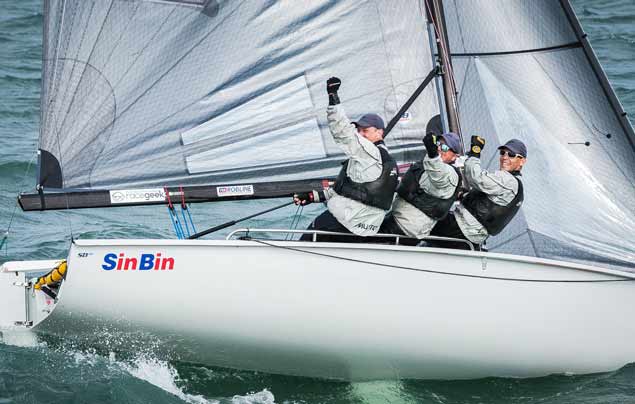 This is us crossing the finish line on the last (fourth) race on day four, our second bullet of the day. We were absolutely shattered and we knew we were close to the start line on a black flag so there was relief mixed with jubilation when we heard the gun. Unscripted, we all punched the air simultaneously. Photo: Anna Zykova
This is us crossing the finish line on the last (fourth) race on day four, our second bullet of the day. We were absolutely shattered and we knew we were close to the start line on a black flag so there was relief mixed with jubilation when we heard the gun. Unscripted, we all punched the air simultaneously. Photo: Anna Zykova
About 20 minutes before the start, we would split off from Broomsticks and do our own thing, look at the wind coming down the course, discuss our likely strategy for the race ahead. We would “ping” the ends of the line with the Velocitek and then we would run along the line to make sure that the Velocitek was accurate and we would determine the favoured end of the line. Every so often, we would do a quick wind reading to see what phase the wind was in. We would have decided by c.3.5 minutes before the start where we are going to start and we would make our way towards the end of the line that we had chosen and line up for the start. After the race, we would typically have a quick chat about what worked, what didn’t work and what happened in the previous race and if we can use any of what we had learnt in the next race. Once ashore, we would take any tension off the rig before enjoying a well-deserved pint. Rinse and repeat!



























